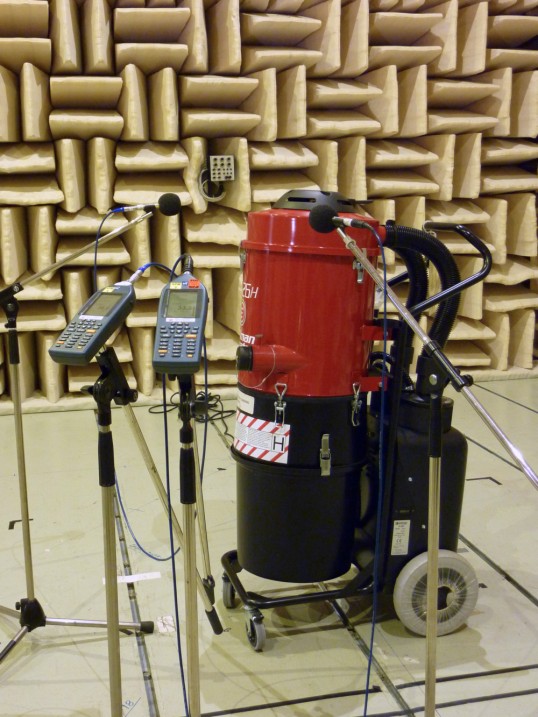- Artificial Intelligence (AI)
- Occupational exposure limit values
- Climate Change and Occupational Safety
- List of CMR substances
- Electromagnetic fields
- Ergonomics
- Industrial Security
- Collaborative robots
- Noise
- Nanoparticles at the workplace
- Optische Strahlung
- REACH
- Reference materials
- Proficiency testing
- Vibration
- Virtual reality
- Work 4.0
The purchasing of low-noise machines

Testing of noise emissions from an industrial vacuum cleaner in the IFA's anechoic measurement chamber
Source: IFA
The IFA has compiled the information needed in order to support companies seeking to purchase noise-emitting machines or replace existing machines with quieter products. The information is divided into the following topics:
- Legal provisions
- Difficulties in implementing the legal provisions
- Assistance in the purchase of machines
Detailed information on the technical specifications (PDF, 122 kB, non-accessible) (noise emission values and standards for determining the emission values) is available for download.
Legal provisions
Exposure to noise at workplaces depends significantly on the noise emissions from the machinery used. For this reason, Section 7 of the German Noise and Vibration OSH Ordinance (PDF, 75 KB) requires the employer (operator) to give priority to noise control aspects when selecting new machines. Before purchasing a machine he must therefore obtain information on the anticipated noise emissions, compare the noise emissions of the products under consideration, and finally select the machine emitting the lowest noise. This does not guarantee however that the machine selected will actually be among the quietest on the market; this can be assumed only if the state of the art of noise emission technology is known for the machine type in question (see also the leaflet FBHM-013 "Leise Maschinen - Auswahl und Beschaffung", in German only). By systematically purchasing low-noise products and replacing using new, quieter replacements for older machines, the company can achieve significant noise reductions whilst at the same time avoiding additional costs for noise abatement measures.
In order to provide companies with the information they need on noise emissions from machinery, the EC Machinery Directive 2006/42/EC (PDF, 1,37 MB) and the 9th Ordinance under the German Product Safety Act (9th ProdSV) with which the directive is transposed in Germany oblige manufacturers and distributors of machines have to state their noise emissions in the user information and in sales brochures or catalogues describing the machines' performance characteristics (see also DGUV-Information FB-HM 023 (PDF, 356 KB), in German only).
Difficulties in implementing the legal provisions
Unfortunately, the legal provisions governing the statement of noise emissions and the selection of low-noise machines are not always easy to implement, for example because:
- Noise emissions labelling by the machine manufacturer is often incorrect
- The noise emissions information is incomprehensible to the purchaser, for example because he is unaware of the difference between the emission sound pressure level and the sound power level, respectively between the parameters for noise emission and immission
- The condition of the machine in real-case operation may differ considerably from the measurement conditions specified in the measurement standard
- The importance of selecting low-noise machines for the anticipated workplace situation is not appreciated
- Priority is given to other machine data, such as performance and price, during procurement of machinery
Guidance for the purchase of machines
When tenders are invited for the supply of a new machine, observance of the state of the art and proven good practice in noise abatement technology should preferably be included in the requirements.
Where possible, concrete values for the noise emissions and the measurement method to be applied (machine-specific measurement standard) should be set out in the invitation to tender. It may also be advantageous for information to be obtained on noise emissions under the anticipated operating conditions in order, for example, for the noise exposure at the workplaces to be predicted with corresponding precision. The noise emissions under the standardized operating conditions may deviate considerably from those under real-case operating conditions.
If the state of the art in noise abatement technology cannot readily be stated for the type of machine in question, for example because observed values are not available or the machines are special or custom-built products, several different machines should be considered in order for the machine emitting the lowest noise to be selected if possible.
The noise data sheet for the procurement of machinery provided in the TRLV technical rules governing noise, Part 3 Annex 3, which also requires a possible need for retesting to be determined, may serve as guidance for formulation of a tender agreement (see also FBHM-013 "Leise Maschinen - Auswahl und Beschaffung", in German only). Further information on the selection of low-noise machines can also be obtained from the German Federal Institute for Occupational Safety and Health (BAuA).
Technical background:

Contact
Ergonomics, Physical environmental factors
Tel: +49 30 13001-3410Fax: +49 30 13001-38001